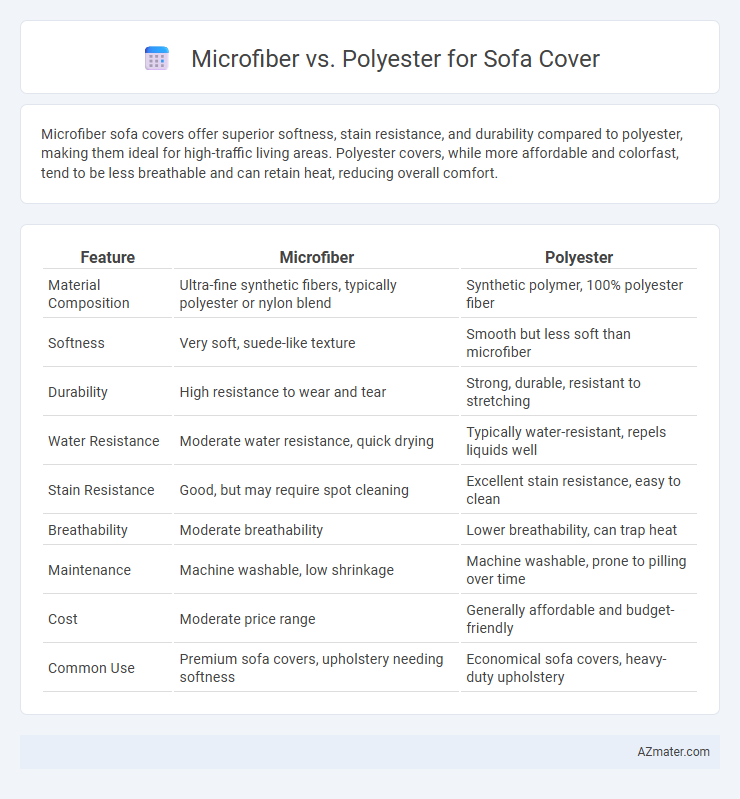Microfiber sofa covers offer superior softness, stain resistance, and durability compared to polyester, making them ideal for high-traffic living areas. Polyester covers, while more affordable and colorfast, tend to be less breathable and can retain heat, reducing overall comfort.
Table of Comparison
| Feature | Microfiber | Polyester |
|---|---|---|
| Material Composition | Ultra-fine synthetic fibers, typically polyester or nylon blend | Synthetic polymer, 100% polyester fiber |
| Softness | Very soft, suede-like texture | Smooth but less soft than microfiber |
| Durability | High resistance to wear and tear | Strong, durable, resistant to stretching |
| Water Resistance | Moderate water resistance, quick drying | Typically water-resistant, repels liquids well |
| Stain Resistance | Good, but may require spot cleaning | Excellent stain resistance, easy to clean |
| Breathability | Moderate breathability | Lower breathability, can trap heat |
| Maintenance | Machine washable, low shrinkage | Machine washable, prone to pilling over time |
| Cost | Moderate price range | Generally affordable and budget-friendly |
| Common Use | Premium sofa covers, upholstery needing softness | Economical sofa covers, heavy-duty upholstery |
Introduction to Sofa Cover Fabrics
Microfiber and polyester are two popular fabric choices for sofa covers due to their durability and ease of maintenance. Microfiber, made from finely woven synthetic fibers, offers a soft, suede-like texture that resists stains and water effectively. Polyester, known for its strength and resistance to wrinkles and fading, provides a budget-friendly option with a wide range of colors and patterns suitable for various interior styles.
What is Microfiber?
Microfiber is a synthetic fabric made from ultra-fine polyester fibers tightly woven to create a soft, durable, and water-resistant material ideal for sofa covers. Its micro-denier threads provide superior stain resistance and breathability compared to standard polyester, enhancing comfort and maintenance. Due to its dense weave, microfiber also offers better resistance to wear and fading, making it a popular choice for furniture upholstery.
What is Polyester?
Polyester is a synthetic fiber made from petroleum-based products, known for its durability, resistance to stains, and wrinkle retention, making it a popular choice for sofa covers. Its moisture-wicking properties and colorfastness contribute to easy maintenance and long-lasting appearance. Polyester fabric offers a smooth texture and good elasticity, balancing comfort and practicality in upholstery applications.
Durability: Microfiber vs Polyester
Microfiber sofa covers offer exceptional durability due to their dense weave and resistance to wear, making them ideal for high-traffic areas. Polyester covers provide good durability as well but tend to show signs of aging faster, such as pilling and fading, especially under frequent use. Investing in microfiber fabric enhances long-term resilience and maintains a fresh appearance compared to standard polyester options.
Comfort and Texture Comparison
Microfiber sofa covers offer a soft, suede-like texture that enhances comfort with a smooth, plush feel ideal for cozy seating. Polyester covers, while durable and resistant to wrinkles, provide a firmer texture that may feel less soft against the skin compared to microfiber. Choosing microfiber prioritizes comfort and tactile softness, whereas polyester emphasizes durability and ease of maintenance.
Stain Resistance and Ease of Cleaning
Microfiber sofa covers excel in stain resistance due to their tightly woven synthetic fibers that repel liquids and prevent absorbing spills, making them easier to clean with just a damp cloth or mild detergent. Polyester covers, while durable and colorfast, tend to absorb stains more readily, requiring more intensive cleaning methods such as machine washing or spot treatment with specialized stain removers. Choosing microfiber enhances longevity and maintains a pristine appearance by minimizing stain penetration and simplifying routine maintenance.
Breathability and Allergen Resistance
Microfiber sofa covers offer superior breathability due to their finely woven fibers that allow better air circulation, reducing heat buildup and enhancing comfort. Polyester sofa covers tend to be less breathable, trapping heat which may cause discomfort during prolonged use. Both materials provide good allergen resistance by repelling dust mites and pet dander, but microfiber's dense weave offers enhanced protection against allergens, making it ideal for sensitive individuals.
Color and Style Options
Microfiber sofa covers offer a wide range of rich, vibrant colors and smooth textures that enhance modern and minimalist decor styles. Polyester covers provide diverse color palettes and patterns, often featuring intricate designs ideal for eclectic or traditional aesthetics. Both materials accommodate various styles but microfiber excels in maintaining colorfastness and a sleek, uniform appearance.
Cost Differences
Microfiber sofa covers typically cost more than polyester due to their superior softness and durability, offering better resistance to stains and wear. Polyester covers are more budget-friendly, making them ideal for households seeking affordable protection without sacrificing basic durability. Cost variations also depend on fabric quality and weave, with microfiber generally commanding a higher price point in the upholstery market.
Which is Better for Your Sofa?
Microfiber offers superior softness, stain resistance, and durability, making it an excellent choice for sofa covers in high-traffic households or with pets and children. Polyester is more affordable and resistant to fading and wrinkles but may lack the plush feel and breathability of microfiber. Choosing microfiber enhances comfort and longevity for your sofa, while polyester suits budget-conscious buyers seeking easy maintenance.

Infographic: Microfiber vs Polyester for Sofa Cover
 azmater.com
azmater.com